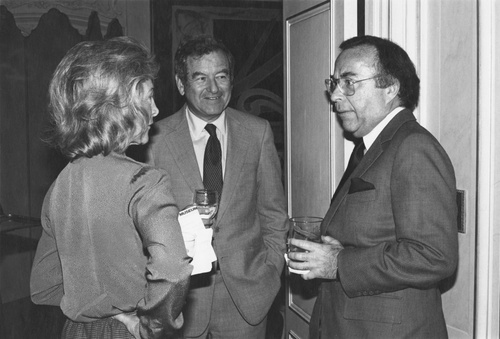Oral History:
Lola Goldring

Left to right: Lola Goldring (event Chair-woman), Allen Goldring (Trustee), and Marcia Tucker (Founding Director) at the New Musem Silent Auction, March 25, 1993. Photo: Catherine McGann
NEW MUSEUM ORAL HISTORY INITIATIVE
LOLA GOLDRING, TRUSTEE AND WIFE OF FOUNDING TRUSTEE ALLEN GOLDRING
INTERVIEWEE: Lola Goldring, Trustee (2007–present) and wife of founding Trustee Allen Goldring
INTERVIEWER: Lisa Phillips, Toby Devan Lewis Director, New Museum
LOCATION: The New Museum Sky Room, May 15, 2014
These interviews are part of the New Museum Oral History Initiative and have been lightly edited from the verbatim transcript. Readers are asked to bear in mind that they are reading a transcript of the spoken word, rather than written prose.
Full transcripts are available from the New Museum Archives by request.
LISA PHILLIPS: Your husband, Allen Goldring, was the first Trustee of the New Museum. The founding Trustee. How were the Board Members involved at the beginning? How active were they and what kinds of roles did they fulfill?
LOLA GOLDRING: I’m trying to think. Brian O’Doherty came with some money from the NEA, and then he left quickly. But that was going to be from the government. Vera List was a friend of Marcia Tucker, the founding Director, from her Whitney Museum times.1 She definitely was extraordinary. She had money, she found a space for us at the New School where we had the first exhibit. She knew everything about art. And Nan Laitman was on very early, and then she lost interest because we got to be a little outré for her, she was more into ceramics and things of that sort. She’s now at the Museum of Art and Design.
LP: So it was a small group?
LG: I guess there were other people but I can’t remember them. Herman Schwartzman, the lawyer, was not very interested in art. And of course his son [Allan Schwartzman, Curator 1977–80] was the first curator. But he took care of all the law work, and Allen [Goldring] took care of all the business work. So Marcia was in business.
LP: What was the vision of the Museum in the early days? Can you remember the founding mission of the Museum?
LG: When I really think about it, what I mentioned before: there was no place for young, new contemporary artists to show their work. And since Marcia got fired from the Whitney, she decided that she needed a place to show their work. And that has always been the vision: to show new art that’s good. And that’s what she did and that’s what we do now. And she didn’t want to have a collection—she wanted to show their art and that would be the end of it. We don’t have a collection.
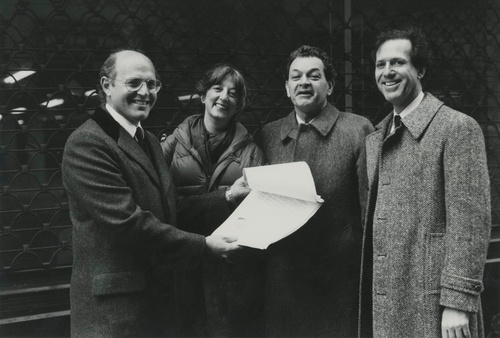
Displaying the deed to the landmark Astor Building at 583 Broadway in SoHo, the New Museum’s home from 1983–2004. Pictured, from left to right: Jonathan Edelstein, Director Marcia Tucker, Trustee Herman Schwartzman, and Elliot Leonard, 1982. Photo: Charles A Schwefel
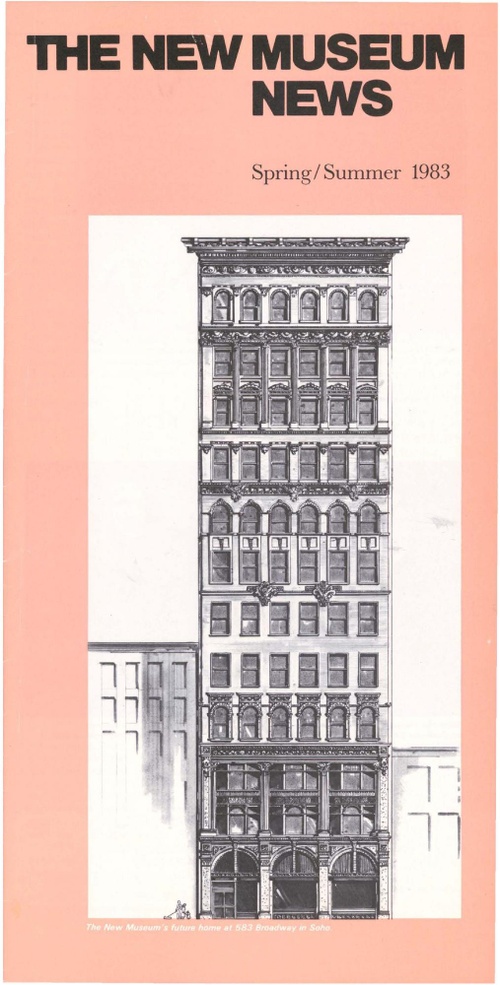
New Museum News, Spring/Summer 1983, announcing the new building at 583 Broadway.
LP: I think it is a strength of the Museum that we don’t, because it allows us to spend our energies on other things. And how do you maintain a collection that will eventually become historical when you are a contemporary art museum? That’s a real dilemma for contemporary art museums.
You spoke a little bit about Vera List, she came on in 1977 and Henry Luce III in ’78. Do you have any other memories about either of them?
LG: Well, Vera was extraordinary. She gave the Museum everything that you can imagine: money, a place to put the art, and she was always right on Marcia’s side. She was great.
Now, Marcia loved Hank—we always found him a little strange, but he also was great and very helpful. He gave money, gave whatever he could. And we struggled along. He got a lot of people on the Board.
There were a lot of people who were more interested in the Museum because Hank Luce was involved, and because Vera was interested.
LP: Was there something unique about the Museum structure at that time? It was calling itself a Museum, but it was tiny.
LG: It was small. Now, Vera gave us a space in the New School for Social Research, and that was really the first time I remember a show, and the first show I remember is Al Jensen. Now it may not have been the first show, but that’s the one that I remember.
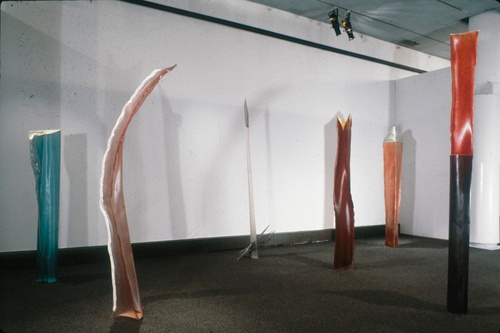
The New Museum’s first exhibition series, “New Work/New York,” presented relatively unknown artists living in New York and was representative of the diversity and vitality of the city’s art community. The series served as a forum for presenting works that had until then received little exposure within a critical and scholarly context. “New Work/New York: Tom Butter, Tom Evans, John Fekner, Judith Hudson, Peter Julian, Cheryl Laemmle,” 1982. Exhibition view: New Museum, New York. Photo: New Museum.
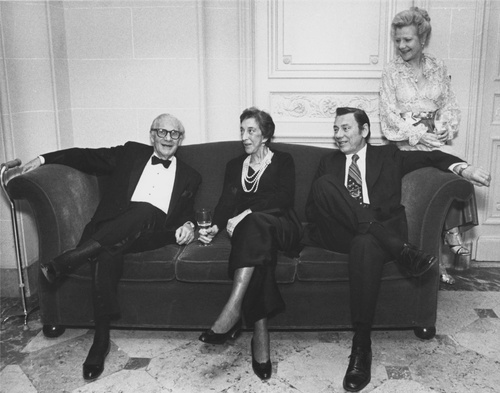
Vera List helped secure the New Museum’s first gallery and offices at the New School of Social Research, the Museum’s home from 1978–83. List (seated center) with John Everett (seated right), President of the New School for Social Research, at the New Museum’s Celebration II benefit, 1980. Photo: Helaine Messer.
LP: So the Activities Council was formed around 1980. You joined it right after it was founded. Were you involved in its founding? And what did the Council do?
LG: Well, I think we were the people who ran the party, and I’m not sure if we were also the people who helped with Art Quest, which was really run by the curators. They would find different artists and different studios–very similar to what we do now, except we went to Keith Haring’s apartment, and he had pictures of the barking dog, and he wanted $250 for a drawing.
I hated the graffiti all over the trains. However, I like his work, and I understand his work now, which I probably didn’t then.
LP: Johanna [Burton] is, you know, the Keith Haring Director of Education.
LG: Oh, that’s right. Yes, and Keith was living with another very good artist, Kenny Scharf.
Johanna Burton: When you visited, were they were living together?
LG: Yes. We had really great visits—we visited the great sculptor Ursula von Rydingsvard too.
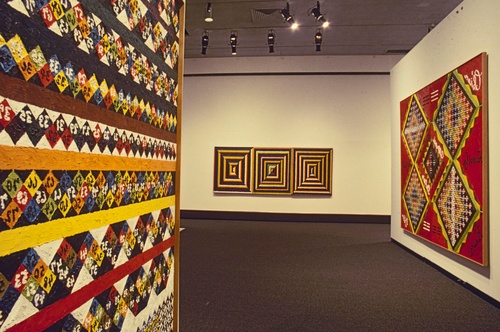
“Alfred Jensen: Paintings and Diagrams from 1957–1977,” the first major retrospective of the artist, opened in March 1978. Exhibition view: New Museum, New York. Photo: New Museum
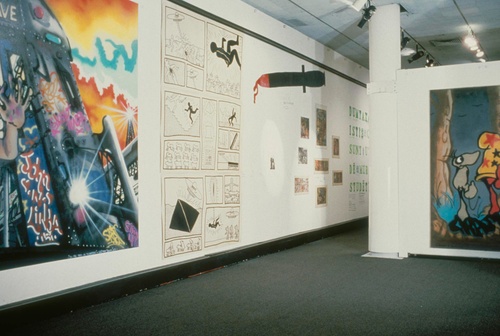
In presenting emergent artistic practices, the New Museum’s exhibitions often challenged established notions of museum practice and taste. “Events: Fashion Moda,” Keith Haring’s first museum exhibition, was organized by and featured several graffiti artists from the South Bronx collective Fashion Moda. Exhibition view: New Museum, New York, 1980. Photo: New Museum
LP: The Museum, in the beginning, was on Hudson Street in a small office space, and then it went to the New School, as you said, and then in 1983 it went to Broadway—
LG: So when it moved to Broadway, we first looked at the building and Allen saw no glass and birds coming in and out of the building. He said, “Oh, how can we buy such a thing? This is the worst.” But two men—who weren’t on the Board as I recall, they were real estate people—somehow got us to buy it. They fixed it up with the proviso that the top floors would be apartments—condominiums—that they would be sold as co-ops.
The street was a blank street, nothing was happening on it. There was no art at all. There were some factory buildings, a glove factory, and we were shocked. It worked out.
LP: But that was a big milestone for the Museum, to go from this little office to the New School and then to this much bigger space on Broadway.
LG: I think we had three floors: we had the basement, the first floor, and the second floor as I recall, and the rest were to be condominiums.
LP: When the Museum opened, were there condominiums already? Were people already living upstairs?
LG: It was just—they fixed it up. They fixed the windows, they put floors in.
LP: But it really was a derelict building, wasn’t it?
LG: Oh it looked terrible. I can tell you that it looked terrible.
LP: It had been sitting there empty for a while.
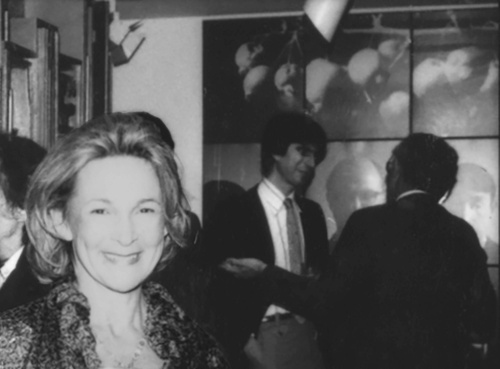
Art Quest, the New Museum’s contemporary collectors’ forum, organized tours of artists’ studios, alternative spaces, and collections, as well as panel discussions and lectures by artists and critics. Lola Goldring (foreground) and curator Ned Rifkin (background) attend an Art Quest event, 1983. Photo: Bonnie Johnson
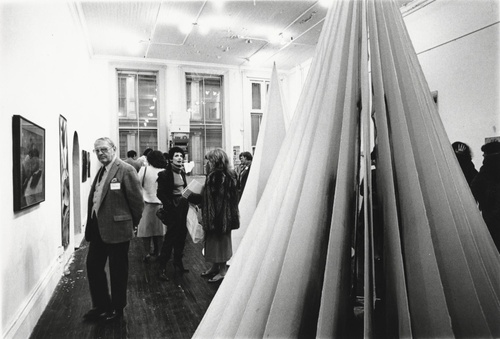
Art Quest Artist-in-Residence tour, 1981. Photo: Lisa Kahane
LG: And it was on an empty street until we moved there—it’s very much like the New Museum here, on the Bowery. Nothing was on the street until we moved here.
LP: Yes, it had a catalyzing effect on Broadway—galleries started moving there, and retail started developing.
LG: It became a shopping street!
LP: There was not much going on before. There were factories, sweatshops, it was kind of scary.
LG: West Broadway—that was fine, and that was the center of SoHo. That was where I used to go with Dody Muller. We went to that one building, 420 West Broadway, and then there was Mary Boone Gallery and Leo Castelli—
LP: Of course, and Paula Cooper was in SoHo, but it was a small community then. And there was the Aldrich Center for Visual Arts that Larry Aldrich had on Prince Street, and he gave the New Museum his library at one point.
LG: Oh, I didn’t know that.
LP: Was the Museum regarded as controversial?
LG: Yes. Controversial, I would say—but it was a place that only a few people went who were interested in cutting-edge art. The ladies that went to see art never came down to the Museum. They went to the MoMA, to the Guggenheim, or whatever. So we had a group that liked the new art and found it interesting. And Marcia had a lot of friends who thought it was great—a lot of art people and a lot of people who understood art. So they came. But it was tough going for a while, and it was not written up like we are written up now. It was tough getting someone from the Times to come down—some of them did, but—
LP: I wonder if it’s possible to be controversial now.
LG: I don’t think so. I don’t think so.

The New Museum’s window facing Broadway, ten years after moving to the Astor Building in 1993. Exhibition view: “Andrea Zittel: Breeding Unit for Reassigning Flight,” 1993. Photo: Fred Scruton
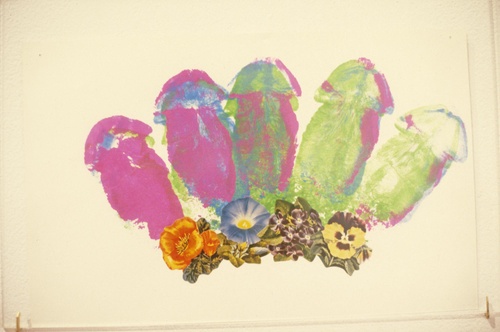
“Extended Sensibilities: Homosexual Presence in Contemporary Art” was the first museum exhibition in the United States to address an important question: In what way and to what extent has some of the most interesting contemporary art addressed and reflected the concerns of the homosexual community? This kind of dialogue, which historically stimulated controversy, remains essential to the New Museum and is a crucial part of the intellectual and aesthetic growth of the Museum’s community of interest. Detail: Les Petites Bonbons, Dayglo Cockprint, 1973. Installation view: New Museum, New York, 1982. Photo: New Museum
LP: When there were controversies, or when there was a bad review, how did the Board respond? Do you remember how Allen may have felt about that? If the Museum was under fire?
LG: I don’t remember. I think that the Board went with Marcia in whatever she wanted to do.
If she wanted a show, nobody said no, nobody questioned it. I may be mistaken, but if you didn’t like what she was doing you left the Board. Whatever Marcia wanted, she got. Much like you.
I don’t think you have a hard Board. I think your Board is easy—they never say, “Oh, I don’t think that should be shown.” Do they?
LP: No. It’s not the Board’s role. Recently, at a retreat, one of the Board Members did ask, “Are we taking enough risks? Are we controversial enough?” So I’m interested in that question of what it means to be controversial, what it means to be taking risks. What does that look like today?
LG: I mean, when you had a show about gay artists, or whatever, at that time it was extraordinarily controversial. I don’t think it’s controversial anymore. If marijuana is getting to be a regular thing in Colorado, then I don’t think anything is very controversial. I don’t know. I don’t think so.
LP: One of the most controversial programs we’ve had since I’ve been here was when we showed a group called the Critical Art Ensemble, and Steve Kurtz was arrested by the FBI for being a suspected bioterrorist.2 Not here at the Museum, but in his studio in Buffalo. But that was—that’s a different type of controversy—people working on the edge of the law, who are in areas that evoke fear, that raise red flags… . So are there any exhibitions that stand out in your memory?
LG: I did write a couple down. “Bad Girls” stands out, and then the very first one that I saw with Al Jensen, and then Baldessari had a wonderful exhibition early on, I think it was at the New School. And then Liza Lou, who had beaded everything, pots, pans—it was extraordinary, the whole room was beaded. I loved that. And then I remember a man in a bed, and he never got out of the bed for a long time. I can’t remember who but I remember he was always in that bed, in a hospital bed.
LP: “Visiting Hours: An Installation by Bob Flanagan in collaboration with Sheree Rose” [1994].
LG: And there was that person who stayed in the window.
LP: Linda Montano, she was there for seven years. The window on Broadway also got a lot of attention.
Do you remember Marcia had very unusual ideas about staff organization?

In 1981, the New Museum presented the first major museum exhibition of West Coast artist John Baldessari. Photo: New Museum

On December 8, 1984, artist Linda Montano began a seven-year performance piece entitled Seven Years of Living Art. For one day each month, Montano occupied the New Museum’s Mercer Street Window, which was painted a designated color corresponding to the seven energy centers of the body. The artist spent the afternoon there providing conversation and counsel on art and life to Museum visitors. Above: Montano wearing red for the first year of the performance, 1984. Photo: New Museum

Linda Montano counseling a visitor in the Mercer Street window during year two (orange), 1986. Photo: New Museum
LG: Yes, I do remember. Everybody was going to be paid the same, and Allen said, “I don’t know if that’s going to work.” And she said, “Oh yes, everybody is going to get paid the same.” It didn’t work, so they changed it. [Laughs.]
LP: So in terms of your experience with the Board and the Museum—you’ve seen it develop so much over almost four decades—how do you see the development and the shift? Do you see it as natural? Do you see it as dramatic?
LG: Well, the Board has grown like the Museum has grown. It got to be much more beautiful, the building itself is very beautiful, the people that are interested are very interested and do a lot more, I think, for the Museum. It’s a lot bigger, it’s a lot more professional, I think.
LP: Do you think Marcia would like that?
LG: I do. I do. Marcia liked anything that made a better museum. If forty people were there and they all gave money and they were all interested in making the Museum a better museum, she would have been right with them, there is no doubt about that.
LP: I know she was very happy to know the Museum was going to survive, that it wasn’t going to disappear. You all worked so hard in those early days. It was a struggle! It’s still a struggle, but it’s a different kind of struggle.
LG: Allen could never understand how the Museum always had a need for money; it never had a balanced budget, never. And that’s not how a businessman runs his business, ever. And she ran the Museum by doing what she could, or she wanted to, and she tried to make the money equal to what she wanted. And I guess we do that still, but I think we’re more professional about it.
[End of Interview]

Contact sheet of New Museum of Contemporary Art staff portraits, 1978.Columns left to right: Marcia Tucker, Allan Schwartzman, and Susan Logan. Photo: Warren Silverman
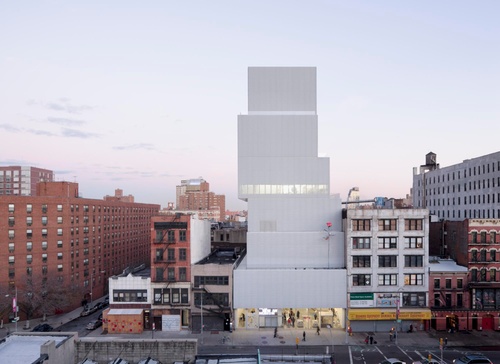
The New Museum opened its current home at 235 Bowery, designed by Sejima + Nishizawa, in 2007. Architectural view: Isa Genzken, Rose II, 2007. Façade installation, New Museum, New York, 2010. Photo: Dean Kaufman
-
Tucker was a curator at the Whitney Museum of American Art from 1969–76.
-
Critical Art Ensemble and Beatriz da Costa were scheduled to perform Genterra on May 2, 2002 at the opening reception of the exhibition “Open_Source_Art_Hack,” in the New Museum’s Media Z Lounge. The interactive performance—which involved releasing genetically modified bacteria—was cancelled due to legal complications.
, May 3 – June 30 2002Open\_Source\_Art\_Hack

